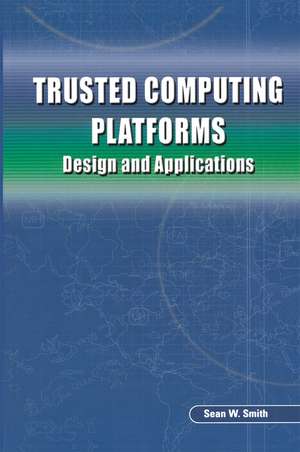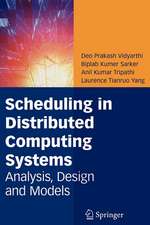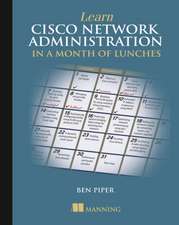Trusted Computing Platforms: Design and Applications
Autor Sean W. Smithen Limba Engleză Paperback – 17 sep 2014
However, these current efforts are just points on a larger continuum, which ranges from earlier work on secure coprocessor design and applications, through TCPA/TCG, to recent academic developments. Without wading through stacks of theses and research literature, the general computer science reader cannot see this big picture.
Trusted Computing Platforms: Design and Applications fills this gap. Starting with early prototypes and proposed applications, this book surveys the longer history of amplifying small amounts of hardware security into broader system security – and reports real case study experience with security architecture and applications on multiple types of platforms. The author examines the theory, design, and implementation of the IBM 4758 secure coprocessor platform and discusses real case study applications that exploit the unique capabilities of this platform. The author discusses how these foundations grow into newer industrial designs, and discusses alternate architectures and case studies of applications that this newer hardware can enable. The author closes with an examination of more recent cutting-edge experimental work in this area.
Trusted Computing Platforms: Design and Applications is written for security architects, application designers, and the general computer scientist interested in the evolution and uses of this emerging technology.
| Toate formatele și edițiile | Preț | Express |
|---|---|---|
| Paperback (1) | 592.03 lei 38-44 zile | |
| Springer Us – 17 sep 2014 | 592.03 lei 38-44 zile | |
| Hardback (1) | 650.73 lei 6-8 săpt. | |
| Springer Us – 10 dec 2004 | 650.73 lei 6-8 săpt. |
Preț: 592.03 lei
Preț vechi: 740.04 lei
-20% Nou
Puncte Express: 888
Preț estimativ în valută:
113.30€ • 123.03$ • 95.17£
113.30€ • 123.03$ • 95.17£
Carte tipărită la comandă
Livrare economică 18-24 aprilie
Preluare comenzi: 021 569.72.76
Specificații
ISBN-13: 9781489997739
ISBN-10: 1489997733
Pagini: 260
Ilustrații: XX, 239 p.
Dimensiuni: 152 x 229 x 14 mm
Greutate: 0.37 kg
Ediția:2005
Editura: Springer Us
Colecția Springer
Locul publicării:New York, NY, United States
ISBN-10: 1489997733
Pagini: 260
Ilustrații: XX, 239 p.
Dimensiuni: 152 x 229 x 14 mm
Greutate: 0.37 kg
Ediția:2005
Editura: Springer Us
Colecția Springer
Locul publicării:New York, NY, United States
Public țintă
ResearchCuprins
Motivating Scenarios.- Attacks.- Foundations.- Design Challenges.- Platform Architecture.- Outbound Authentication.- Validation.- Application Case Studies.- TCPA/TCG.- Experimenting with TCPA/TCG.- New Horizons.
Notă biografică
Sean Smith is currently on the faculty of the Department of Computer Science at Dartmouth College, serves as director of the Cyber Security and Trust Research Center at Dartmouth's Institute for Security Technology Studies, and also serves as Principal Investigator of the Dartmouth PKI Lab. His current research and teaching focus on how to build trustworthy systems in the real world. He previously worked as a scientist at IBM T.J. Watson Research Center, doing secure coprocessor design, implementation and validation; and at Los Alamos National Laboratory, doing security designs and analyses for a wide range of public-sector clients. Dr. Smith was educated at Princeton (B.A., Math) and Carnegie Mellon (M.S., Ph.D., Computer Science).
Textul de pe ultima copertă
How can one trust computation taking place at a remote site, particularly if a party at that site might have motivation to subvert this trust? In recent years, industrial efforts have advanced the notion of a "trusted computing platform" as a building block. Through a conspiracy of hardware and software magic, these platforms attempt to solve this remote trust problem, to preserve various critical properties against various types of adversaries.
However, these current efforts are just points on a larger continuum, which ranges from earlier work on secure coprocessor design and applications, through TCPA/TCG, to recent academic developments. Without wading through stacks of theses and research literature, the general computer science reader cannot see this big picture.
Trusted Computing Platforms:Design and Applications fills this gap. Starting with early prototypes and proposed applications, this book surveys the longer history of amplifying small amounts of hardware security into broader system security---and reports real case study experience with security architecture and applications on multiple types of platforms. The author examines the theory, design, implementation of the IBM 4758 secure coprocessor platform and discusses real case study applications that exploit the unique capabilities of this platform. The author discusses how these foundations grow into newer industrial designs, and discusses alternate architectures and case studies of applications that this newer hardware can enable. The author closes with an examination of more recent cutting-edge experimental work in this area.
Trusted Computing Platforms:Design and Applications is written for security architects, application designers, and the general computer scientist interested in the evolution and uses of this emerging technology.
However, these current efforts are just points on a larger continuum, which ranges from earlier work on secure coprocessor design and applications, through TCPA/TCG, to recent academic developments. Without wading through stacks of theses and research literature, the general computer science reader cannot see this big picture.
Trusted Computing Platforms:Design and Applications fills this gap. Starting with early prototypes and proposed applications, this book surveys the longer history of amplifying small amounts of hardware security into broader system security---and reports real case study experience with security architecture and applications on multiple types of platforms. The author examines the theory, design, implementation of the IBM 4758 secure coprocessor platform and discusses real case study applications that exploit the unique capabilities of this platform. The author discusses how these foundations grow into newer industrial designs, and discusses alternate architectures and case studies of applications that this newer hardware can enable. The author closes with an examination of more recent cutting-edge experimental work in this area.
Trusted Computing Platforms:Design and Applications is written for security architects, application designers, and the general computer scientist interested in the evolution and uses of this emerging technology.
Caracteristici
Work in this area is both important and timely. It is the basis of research on secure devices ranging from high-end smart cards to the Java buttons to secure operating systems, secure financial systems, and even systems as diverse as those protecting homeland security information One point that is especially timely will be in the last chapter, where the author discusses future directions and the emerging steps of NGSCB Includes supplementary material: sn.pub/extras
















